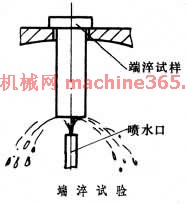1) procedure qualification test


工艺评定试验
1.
This paper which is about the welding procedure qualification test of the SA213-T23 steel pipe,analysis the influence of post heat-treatment on the weld joint,and got the right welding process.
本文主要通过对 SA213-T23钢小径管的焊接工艺评定试验,分析焊后热处理对 T23钢焊接接头性能的影响, 从而确定正确的焊接工艺。
3) the process evaluation experiment


工艺评价试验
4) process qualification


工艺鉴定试验
5) technological test


工艺试验
1.
Through a series of technological tests, the temperature range of OSTE was determined, and the crack has been avoided through improving the temper process.
通过系列回火工艺试验,确定了65Mn钢第一类回火脆性出现的温度范围。
2.
By remaking now available glow ion nitrogen furnace and technological test, the range of ion nitrogen is enlarged, the questions of oxide and being out of shape are solved.
通过改造现有辉光离子氮化炉及工艺试验 ,扩大离子氮化的氮化范围 ,解决离子氮化后的氧化及变形问题。
3.
At the same time, a lot of parameters of technological test are gained through a series of ore uranium extractin.
围绕溶浸采矿这个主题 ,从岩、矿石的物质成分 ,矿石结构构造 ,铀的存在形式 ,岩、矿石物理力学参数 ,矿体形态、产状、规模及矿床水文地质等诸多方面阐述了大布铀矿床溶浸的天然地质条件 ,并通过一系列矿石铀浸出工艺试验 ,获得大量溶浸工艺参数 ,提出大布铀矿床以原地破碎浸出辅以堆浸为最佳采矿方案。
6) process test


工艺试验
1.
The test takes the combination of SBR and biological contact oxidation as its ruling technique through the comparison of multiple antibiotic mixed wastewater process tests to single antibiotic wasterwater process test,and the result shows that the treatment of mixed multiple antibiotic wastewater is superior to single antibiotic wastewater.
试验以SBR+生物接触氧化为主导工艺,通过多品种抗生素混合废水工艺试验与单一抗生素废水工艺试验结果的对比分析,得出多品种抗生素废水混合后处理效果优于单一抗生素废水处理效果。
2.
Giving focus to its structural and mathematical models,kinetic analysis,process testing results and advantages,the article introduces a type of dual-vibration screen based on innovative working principle and mechanism.
提出了一种采用全新原理、全新结构的复振筛,主要介绍了复振筛的结构模型、数学模型、动力学分析、工艺试验的效果及优点。
补充资料:机械工程材料:热处理工艺性试验
测定材料或零件在热处理工艺过程中获得预期热处理效果的难易程度的工艺性能试验。由於热处理工艺的多样性﹐不可能用单一的性能指标来表徵和评定。常见的热处理工艺性能有淬透性﹑晶粒长大倾向﹑淬裂敏感性﹑脱碳敏感性﹑回火脆性等。
淬透性 表示钢在淬火时整个截面被淬硬的深浅程度﹐一般用钢在淬火时能够在整个圆柱截面上淬硬的最大临界直径表示。最常用的淬透性标準试验方法为端淬试验法。採用这种方法时﹐将规定尺寸的试样加热到淬火温度﹐然后在试验机上一端喷水冷却(见图 端淬试验 ) ﹐试样完全冷却后测定沿其整个高度上的表层硬度分布﹐以端面至淬硬到规定硬度值的距离表徵。
﹐试样完全冷却后测定沿其整个高度上的表层硬度分布﹐以端面至淬硬到规定硬度值的距离表徵。
晶粒长大倾向 或称过热敏感性﹐指金属在加热过程中晶粒粗化倾向的大小。一般测定不同温度时金属的晶粒度﹐以晶粒开始急剧长大时的温度来衡量晶粒长大倾向。
淬裂敏感性 金属在淬火时產生裂纹的倾向。没有统一的标準评定方法﹐一般用一定形状的试样经不同冷却能力的淬冷介质淬火后﹐统计出现裂纹的多少来进行相对比较。
脱碳敏感性 钢在加热和保温过程中表层的碳逸出氧化的倾向。一般将试样在相应的加热环境下保持一定时间后﹐用金相法或剥层分析法测定脱碳层的深浅来评定。这对轴承﹑刀具﹑模具﹑弹簧等用钢是一种很重要的指标。
回火脆性倾向 淬火钢在400~600℃温度区间回火时的脆化现象﹐也称可逆回火脆性。一般用钢在回火后慢冷状态下和水冷状态下的衝击韧性比值大小来衡量﹐也可以用回火后快冷和慢冷两种不同状态下钢的脆性转折温度的变化大小来衡量。
淬透性 表示钢在淬火时整个截面被淬硬的深浅程度﹐一般用钢在淬火时能够在整个圆柱截面上淬硬的最大临界直径表示。最常用的淬透性标準试验方法为端淬试验法。採用这种方法时﹐将规定尺寸的试样加热到淬火温度﹐然后在试验机上一端喷水冷却(见图 端淬试验 )
 ﹐试样完全冷却后测定沿其整个高度上的表层硬度分布﹐以端面至淬硬到规定硬度值的距离表徵。
﹐试样完全冷却后测定沿其整个高度上的表层硬度分布﹐以端面至淬硬到规定硬度值的距离表徵。 晶粒长大倾向 或称过热敏感性﹐指金属在加热过程中晶粒粗化倾向的大小。一般测定不同温度时金属的晶粒度﹐以晶粒开始急剧长大时的温度来衡量晶粒长大倾向。
淬裂敏感性 金属在淬火时產生裂纹的倾向。没有统一的标準评定方法﹐一般用一定形状的试样经不同冷却能力的淬冷介质淬火后﹐统计出现裂纹的多少来进行相对比较。
脱碳敏感性 钢在加热和保温过程中表层的碳逸出氧化的倾向。一般将试样在相应的加热环境下保持一定时间后﹐用金相法或剥层分析法测定脱碳层的深浅来评定。这对轴承﹑刀具﹑模具﹑弹簧等用钢是一种很重要的指标。
回火脆性倾向 淬火钢在400~600℃温度区间回火时的脆化现象﹐也称可逆回火脆性。一般用钢在回火后慢冷状态下和水冷状态下的衝击韧性比值大小来衡量﹐也可以用回火后快冷和慢冷两种不同状态下钢的脆性转折温度的变化大小来衡量。
说明:补充资料仅用于学习参考,请勿用于其它任何用途。
参考词条